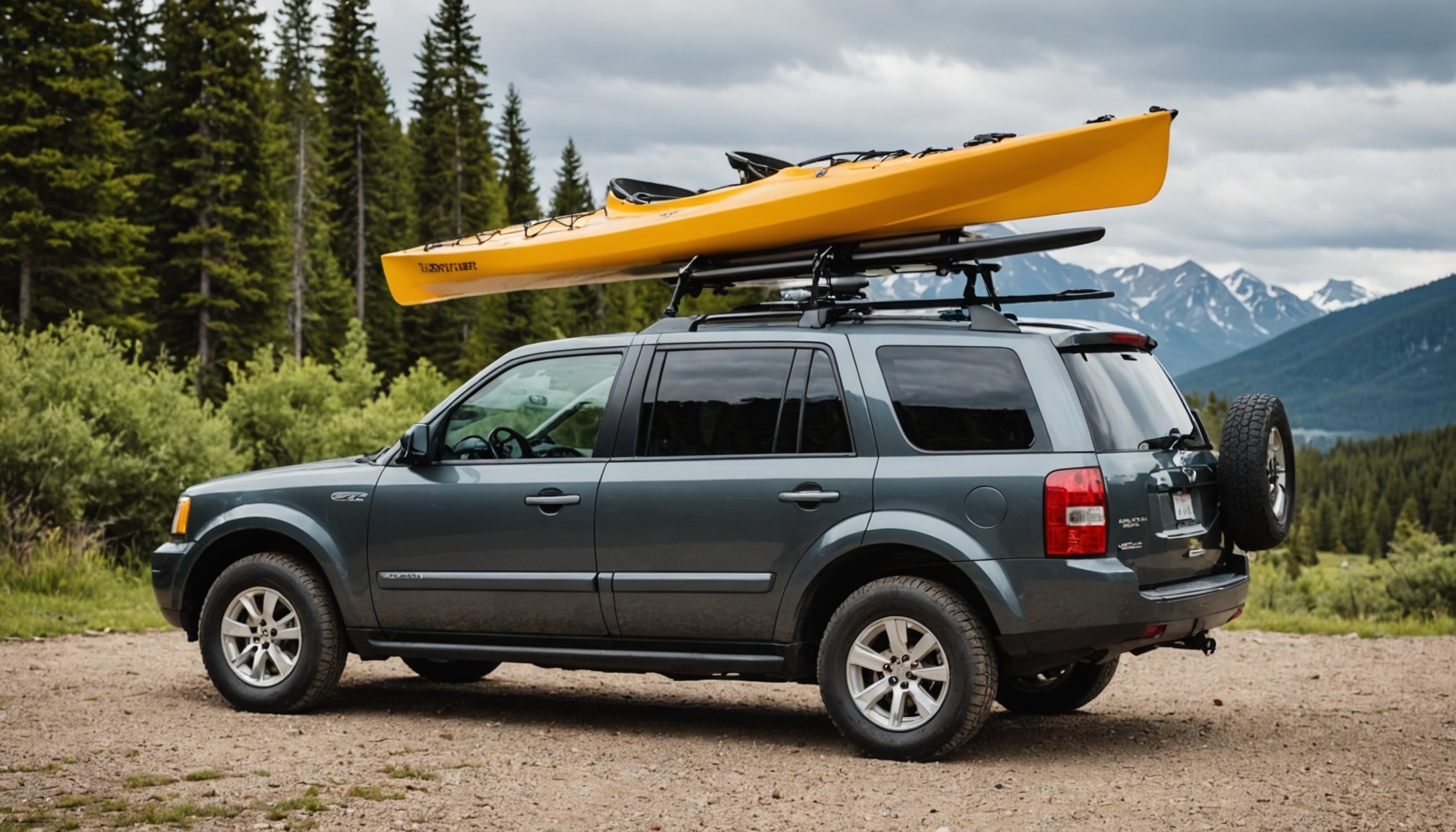The Ultimate Guide to Securely Roof-Racking Your Kayak on an SUV: Travel Without Worries of Shifting
Understanding the Importance of a Good Kayak Rack
When you’re eager to hit the water with your kayak, the last thing you want to worry about is whether your kayak is securely fastened to your SUV. A good kayak rack is more than just a convenience; it’s a necessity for safe and stress-free transport. Here’s why:
- Safety First: A properly secured kayak ensures that it won’t shift or fall off during transport, which could lead to accidents or damage to your vehicle and the kayak itself.
- Convenience: The right rack makes loading and unloading your kayak a breeze, saving you time and effort.
- Protection: A good rack protects both your kayak and your vehicle from scratches and dents.
Types of Kayak Roof Racks
Choosing the right kayak rack can be overwhelming, given the variety of options available. Here are the main types of kayak roof racks you should consider:
This might interest you : Ultimate guide to supercharge your windshield defrosting in frigid conditions: key strategies for optimal cold weather performance
Saddle Mounts
Saddle mounts are a popular choice, especially for those using Yakima or Thule systems. These racks position your kayak with the deck pointing up, providing good padding and preventing scratches. They are easy to load from the back by sliding the kayak forward over the crossbars[1].
Pros:
Have you seen this : Maximize safety: essential tips for seamlessly integrating child car seats with your vehicle’s safety features
- Good stability and protection for the kayak.
- Easy to load and unload.
Cons:
- Can be difficult to load by yourself.
- May not be suitable for very wide or long kayaks.
Hitch Racks
Hitch racks attach to your truck’s hitch and provide a crossbar that extends behind the vehicle. These are typically the most affordable and convenient option but are limited to carrying one kayak.
Pros:
- Easy to install and disconnect.
- Provides stability and is convenient for loading.
Cons:
- Increases the length of your vehicle, which can affect parking and driving.
- Limited to carrying one kayak[1].
Lumber Racks
Lumber racks are elevated racks similar to those on utility trucks. They are great for carrying multiple kayaks but are the bulkiest option and often require drilling holes into your truck bed for installation.
Pros:
- Can carry several kayaks.
- Provides high clearance.
Cons:
- Bulky and may obstruct visibility.
- Requires drilling into the truck bed[1].
Inflatable Soft Roof Racks
For those who prefer a more temporary solution, inflatable soft roof racks are a great option. These racks are easy to install without tools and can be deflated and stored when not in use.
Pros:
- Easy to install and store.
- Suitable for most car models.
- Durable 600D TPU material.
Cons:
- Limited weight capacity (60kg).
- May not provide the same level of stability as other racks[3].
What to Consider When Buying a Kayak Rack
Before making a purchase, there are several key factors to consider to ensure you get the right rack for your needs.
Kayak Size and Length
The size and length of your kayak are crucial considerations. Traditional kayaks are wider than ocean kayaks, so if you have a wide kayak, you may need a J-cradle roof rack or stacker mount. Longer kayaks, such as tandem kayaks, require more stability and may need racks with lift assist systems[1].
Example:
If you own a tandem kayak, you’ll need a rack that can handle the extra length and weight. A Thule rack with lift assist can make loading and unloading much easier.
Weight Capacity
Ensure the rack you choose has a weight capacity that can handle your kayak. If you plan to add more kayaks to your collection in the future, consider a rack that can handle multiple kayaks.
Tip:
Always check the weight capacity of the rack and your vehicle’s roof rating to ensure compatibility.
Materials
Racks are typically made from aluminum or steel. Aluminum is lighter and more resistant to corrosion but less durable and often more expensive. Steel is stronger and more affordable but can rust if scratched[1].
Quote:
“Aluminum racks are a great choice if you’re looking for something lightweight, but if you prioritize durability, steel might be the better option,” says a Gear Guide at Rack Attack DC.
Ease of Use
Ease of use is a critical factor, especially if you’re loading the kayak by yourself. Lift assist systems and J-cradles are often preferred for their simplicity.
Example:
Lift assist racks, like those from Thule, allow you to mount the kayak on the side of your vehicle before lifting it to the roof, making the process much easier.
Storage
If you plan to keep the rack on your car year-round, storage won’t be an issue. However, if you prefer to store it during the off-season, consider racks that are easy to remove and store.
Tip:
J-cradles and saddle mounts are generally easy to store, while racks with lift assist can be bulkier.
Securing Your Kayak: Step-by-Step Guide
Securing your kayak to the roof rack involves several steps to ensure it is safe and stable during transport.
Step 1: Prepare Your Vehicle
Ensure your vehicle has crossbars or a roof rack system installed. If not, you can check the fit of your car using tools from Yakima or Thule[2].
Step 2: Load the Kayak
Place the kayak onto the rack, ensuring it is centered and balanced. For saddle mounts, load the kayak from the back by sliding it forward over the crossbars.
Step 3: Use Straps and Tie-Downs
Use ratchet straps and tie-downs to secure the kayak to the rack. Here’s a detailed list of what you need:
- Ratchet Straps: These provide the primary securing force. Make sure they are tightened evenly.
- Tie-Downs: Use bow and stern tie-downs to secure the kayak to the front and rear of your vehicle.
- Foam Blocks or Pool Noodles: These can be used to protect the kayak and your vehicle from scratches.
- Quick Loop Straps: These are useful for additional security and ease of use[3].
Example:
When using an inflatable soft roof rack, you’ll receive 4 adjustable tie-down straps, 4 quick loop straps, and 4 bow and stern tie-down cords. These ensure your kayak is securely fastened to your car roof.
Table: Comparing Different Types of Kayak Racks
Here’s a comprehensive table to help you compare the different types of kayak racks:
| Type of Rack | Pros | Cons | Weight Capacity | Ease of Use |
|---|---|---|---|---|
| Saddle Mounts | Good stability, easy to load | Difficult to load by oneself, not suitable for very wide kayaks | Varies | Medium |
| Hitch Racks | Easy to install, convenient, stable | Increases vehicle length, limited to one kayak | Varies | High |
| Lumber Racks | Can carry multiple kayaks, high clearance | Bulky, requires drilling into truck bed | High | Low |
| Inflatable Soft Racks | Easy to install, store, and transport; durable material | Limited weight capacity (60kg) | 60kg | High |
Practical Tips and Advice
Here are some practical tips to make transporting your kayak a breeze:
- Always Check the Weather: Before heading out, ensure the weather is suitable for transporting your kayak. Strong winds or heavy rain can make the journey unsafe.
- Use Additional Protection: Use foam blocks or pool noodles to protect your kayak and vehicle from scratches.
- Regular Maintenance: Regularly check your rack and straps for wear and tear. Replace any damaged parts to ensure safety.
- Practice Makes Perfect: If you’re new to loading kayaks, practice in a safe area before hitting the road.
Quote:
“Loading a kayak onto a roof rack can seem intimidating at first, but with practice, it becomes second nature. Always make sure to double-check your straps and tie-downs,” advises a kayaking enthusiast.
Transporting your kayak securely is a combination of choosing the right rack, following the correct loading and securing steps, and using the right accessories. By understanding the different types of kayak racks, considering your specific needs, and following practical tips, you can ensure a safe and enjoyable journey to your kayaking destination.
Remember, the key to a stress-free trip is preparation and attention to detail. Whether you’re using a saddle mount, hitch rack, or inflatable soft roof rack, make sure you take the time to secure your kayak properly. Happy paddling











